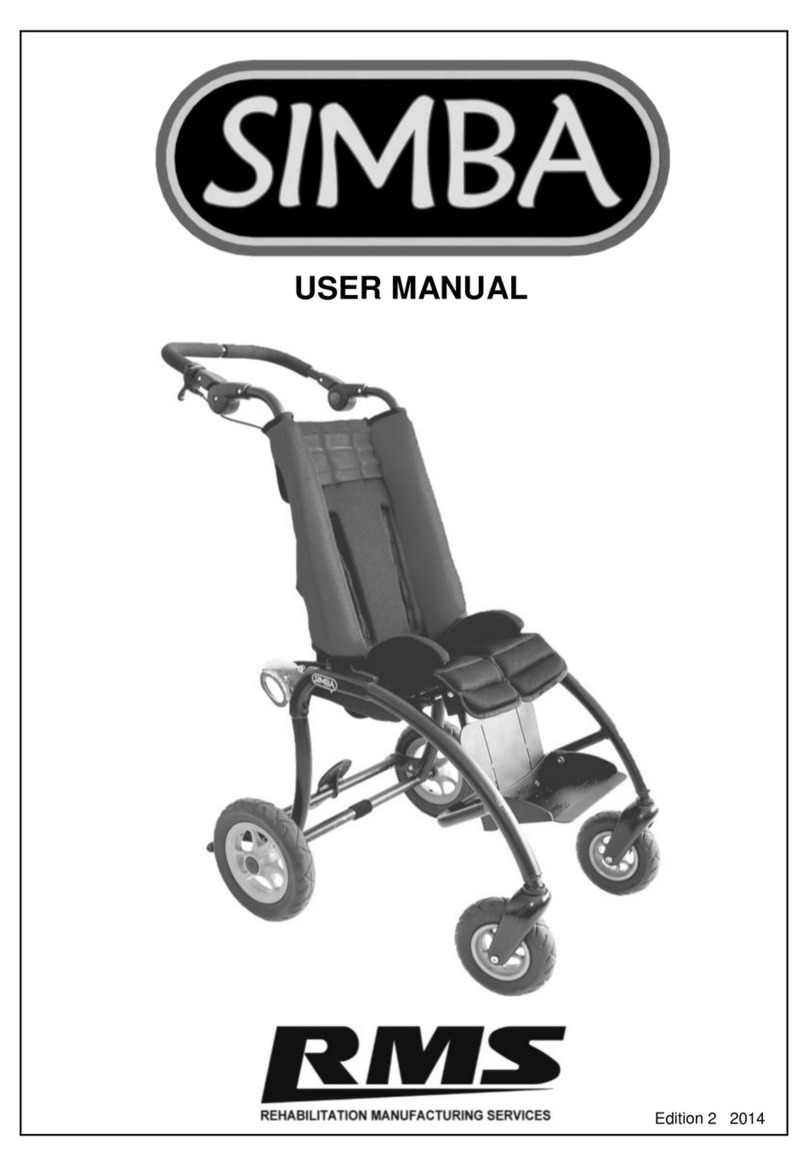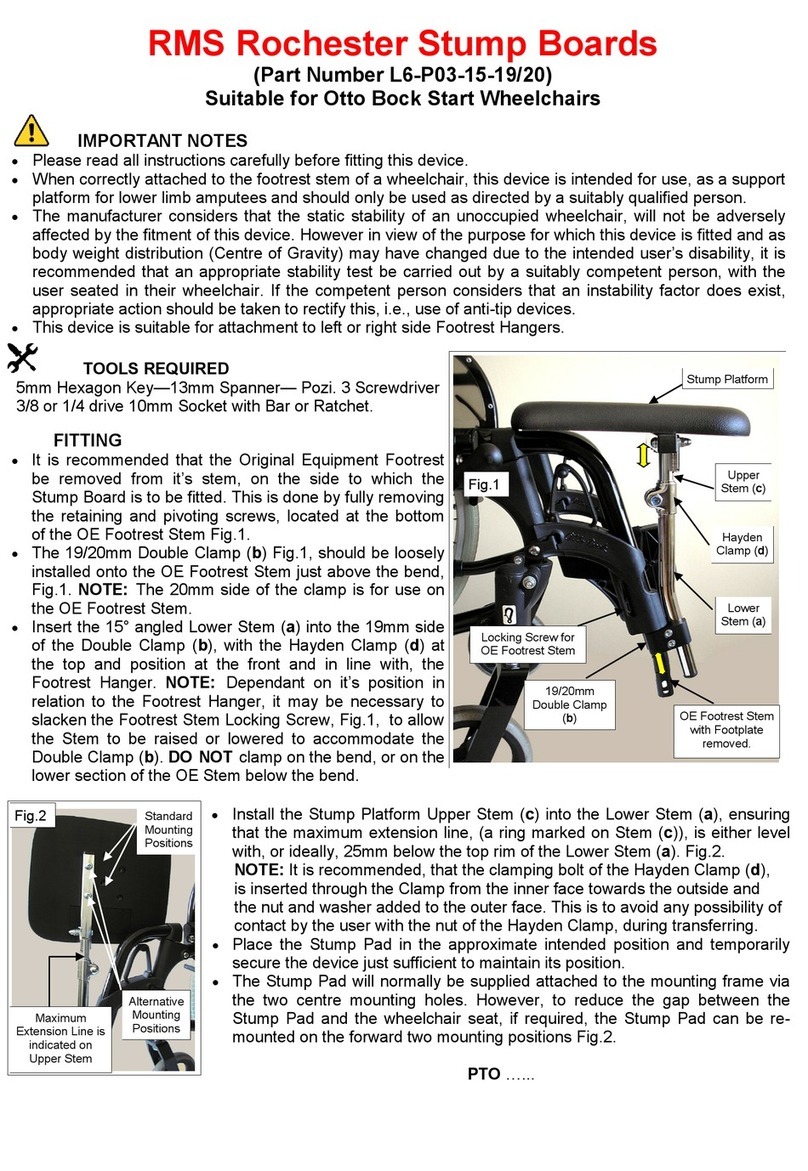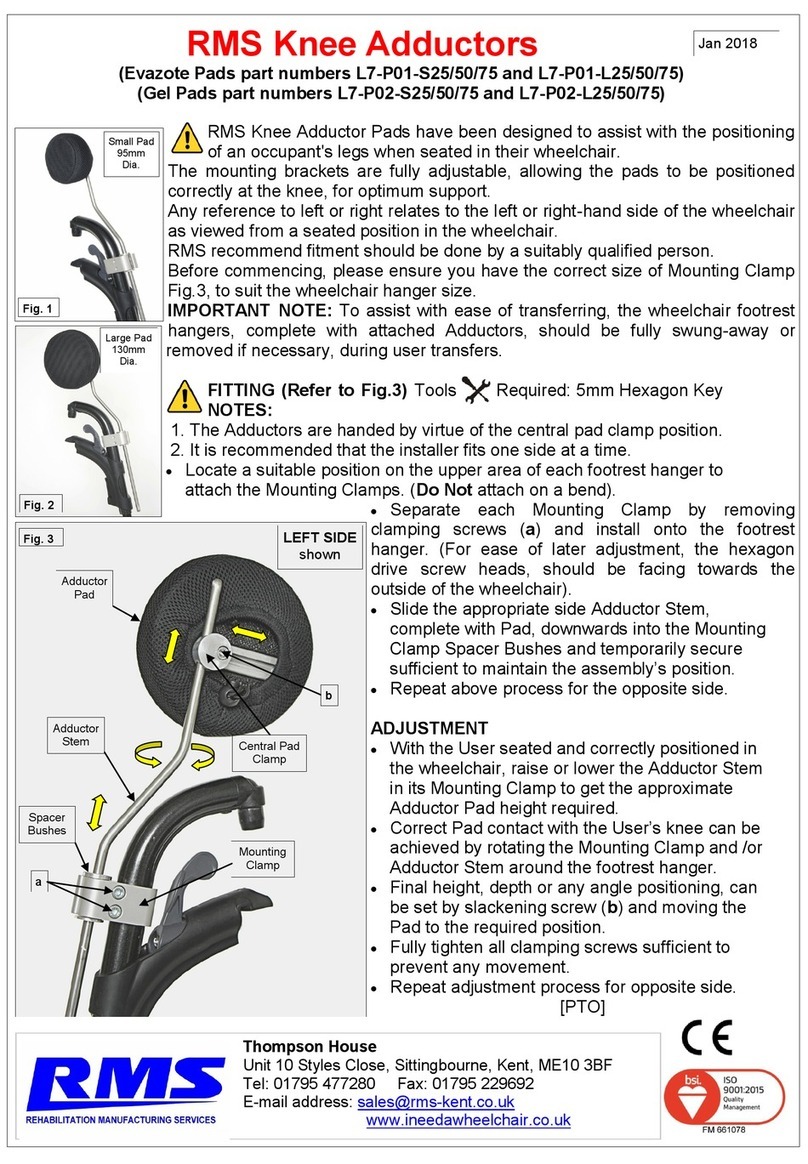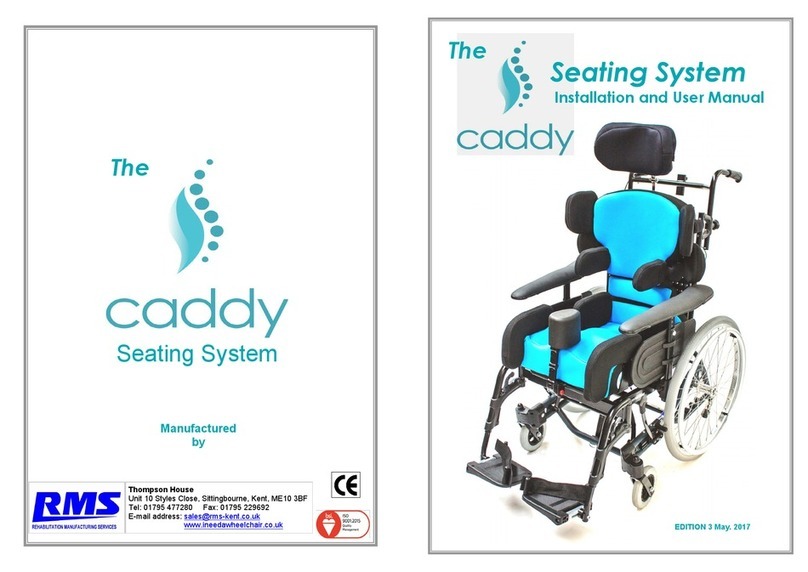RMS Gill 4 Seating System EDTION TWO 2012 User manual

The
New
Seating System
The Perfect Partnership
The Perfect Partnership
The Perfect Partnership
USER
MANUAL
EDTION TWO
2012
4
Discovery Edition

INTRODUCTION
The Gill 4 Seating System is the result of experienced, thoughtful design
and rigorous testing over 16 months of field trials, in-house testing and frontal
impact testing. The Gill 4 Seating System was successfully tested to ISO 16840-
4 at the Transport Research Laboratory in March 2012.
Many adjustable features have been built into the Gill 4, enabling it to
become an extremely versatile seating system, available in three sizes.
With two backrest options available, the Gill 4 Seating System has been
designed specifically by our engineers, to meet the known wide range of
demands placed on postural positioning seat units.
The “Dynamic” Backrest option, offers the ability to absorb the type of
thrusting forces, placed on it during user extensor spasms, with a uniquely
designed absorbing system, which is variable to suit individual user
requirements.
The “Fixed” Backrest option, offers the same supportive capabilities as a normal
rigid back seat unit, but with angle adjustment available to 90, 95 and 100
degrees.
RMS Ltd reserves the right to change without notice, the design, methods
of manufacture, or raw materials used in the construction of the Gill 4 Seating
System, where it considers such changes will serve to improve the product
quality, or become necessary to meet any changes in device legislation.
Should the reader have any concerns regarding the installation, set-up,
adjustments, or use of the Gill 4 Seating System, please contact the RMS Ltd
Technical Help-line on 01634-578881.
Contents
Gill 4 Seat Plan ....................................................... 3
Safety Guidelines ....................................................4
Initial Installation ..................................................... 5
Inserting Gill 4 into Discovery wheelbase .............. 6
Adjusting the Gill 4 Seating System ...................... 7
Seat Depth and Sidearms ..................................... 7
Sacral Support Panel and Pelvic Supports ........... 8
Thoracic Supports ................................................. 9
Headrest ................................................................10
Notes regarding Backrest adjusting ..................10-11
Footrests ............................................................... 11
Anklesures installation and use .............................12
Anti-thrust Seat depth adjustment .........................13
Abductor (Pommel) Install and Adjust ..............14-15
Upholstery and Cleaning .......................................16
Transportation information ................................17-20
Technical Data ..................................................20-21
Warranty Statement .............................................. 22
General Information .............................................. 23
Product Maintenance ............................................ 23
2

Both Fixed and Dynamic Seat Units are supplied as standard, with the following
features:-
Quick-release Interface.
Depth-adjustable Anti-thrust Seat Cushion.
Width adjustable full-length fixed Pelvic Supports.
Width adjustable swing-away Thoracic Supports.
Adjustable Sacral Support.
RMS type “D” Headrest.
RMS PB003 Pelvic Belt.
Machine washable, removable Upholstery.
Optional Accessories available:
Footrest Mounting Frame c/w multi-positional Footplates, Anklesure Foot
Controls, Sidearms with height and depth adjustment, Leg Abductors, Various
Harnesses and Pelvic Belt options. Clear plastic or Ply laminate Contoured
Trays (for use with G4-05-01 Sidearm Kits)
3
Gill 4 SEAT PLAN
RMS Type “D” Headrest
with angle-adjustable stem
Removable
Footrest Support
Frame
Padded
Pelvic Supports
Positive Locking
Swing-away
Thoracic Supports
Depth-adjustable
Backrest Support
Dynamic
Thrust Absorber
Removable and
Machine washable
Upholstery
Adjustable Anti-
Thrust Cushion
Height and
Depth-adjustable
Sidearms
Adjustable
Sacral Support
Fig. 1

4
SAFETY GUIDELINES
Due to the various activities that a wheelchair user has to perform, RMS Ltd
recommends that, prior to issuing the GILL 4 Seating System and the
wheelchair into which it is to be interfaced, this manual, together with any
wheelchair manufacturer’ User Guide, should be studied by all relevant
persons, to ensure that all instructions, procedures and warnings are carefully
observed and understood.
For correct support and user comfort, it is strongly recommended that the
initial installation any adjustments and final hand-over are carried out by a
suitably qualified person.
The maximum occupant capacity of a complete GILL 4 Seating System for
transportation purposes, when interfaced into a wheelchair with a seat width
up to 17”, is 50Kg (7.8 stones).
As the installation of a GILL III System may raise or position the user further
forward in their wheelchair, an appropriate stability test should be carried out
prior to final commissioning.
After the GILL 4 Seating System has been initially adjusted to suit the
individual user, any settings should not be affected subsequently, by the
removal and refitting of the Seat Unit to allow the wheelchair to be folded.
However, care should be taken not to impact adjustable components whilst
the Seat Unit is removed from the wheelchair, as this could affect their
original pre-set position.
To accommodate any changes in user growth or postural positioning, it is
recommended that the user be checked at regular intervals by a suitably
qualified person, to ensure that adjustable components are correctly set to
suit the user’s current requirements.
Carers should ensure correct utilisation of any positioning Straps or
Harnesses, as failure to do so could result in injury to the user. It is
recommended that any Postural Straps or Harnesses being used, are the
first items to be secured when the user enters the seat and the last items to
be released before exiting.
Worn or damaged upholstery can lead to hygiene contamination, cause
injury to the user and, in some cases, fail to support the user correctly.
Regular inspections of all upholstery should be made and any defects
should be reported to the relevant authority for rectification as soon as
possible.
Ancillary devices, such as the Headrest, positioning Straps and Harnesses,
Kneeblock or Pommel should be checked for security and positioning on a
daily basis.
The wheelchair parking brakes should always be applied before attempting
to transfer the occupant, removing or refitting the GILL 4 System or making
any adjustments.
Never hang heavy objects on the GILL 4 Seating System or any part of the
wheelchair, as this could seriously affect the overall wheelchair stability.

INITIAL INSTALLATION
The information contained in this User Manual, relates to the Gill 4 Seating
System being interfaced with an appropriate sized Otto Bock Discovery
wheelbase, fitted with an M30 Parallel Adapter Frame.
IMPORTANT NOTES:
The Gill 4 Seating System and Discovery wheelbase, when supplied as
a “G4—Disco Package”, will be assembled ready to be interfaced
together. However, the installer should note that whilst the Gill 4 and
Discovery will leave RMS Ltd set to the specifications detailed on the
original assessment prescription, some minor adjustments of either the
Seat or Backrest components may be necessary to ensure the final
correct seating support is achieved.
Any reference to Left or Right in this manual, will refer to the Left or
Right side when sitting forward facing in the Seat Unit.
Gill 4—Discovery Compatibility:
Where a Gill 4 Seating System is
supplied for use with a currently owned
Discovery wheelbase, it will be
necessary to ensure that the correct
*Interface Parallel Adapter, as detailed
below, is securely installed onto the
wheelbase in the most suitable position.
Gill 4 size 1—36cm Discovery only.
Use RMS G4 size 1 interface with
*M30 Parallel Adapter HR32048200
Gill 4 size 2—40cm Discovery only.
Use RMS G4 size 2 interface with
*M30 Parallel Adapter HR32048300
Gill 4 size 3—45cm Discovery only.
Use RMS G4 size 2 interface with
*M30 Parallel Adapter HR32048400
NOTE:
Whilst Figs.2, 3 and 4 give examples of
the Parallel Adapters fitted to three sizes
of Discovery wheelbases, some slight
adjustment of these may be necessary
where stability becomes an issue
created by changes in the user’s
disability.
5
Fig. 2
Fig. 3
Fig. 4
36cm Discovery
40cm Discovery
45cm Discovery
Table of contents
Other RMS Wheelchair manuals























